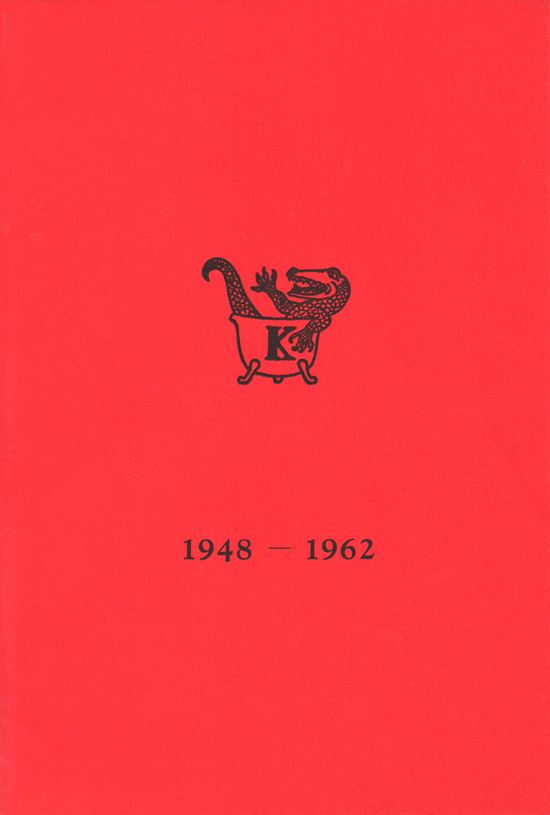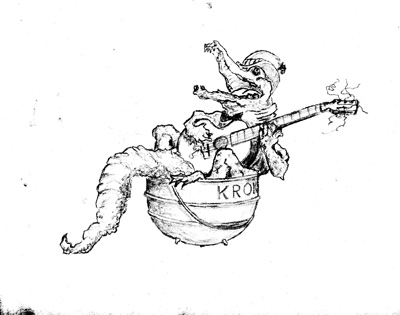Undergrads
Brooks
Danner
Ebel
Elwell
Gail
Harken
Horseley
Paul
Pepin
Putnam
Rockefeller
Tucker
Wadsworth
Wilson
Woodbury
Special Guest:
Windell
Graduates
Bursk
Biddle
Binger
Bohen
Cabot
Cave
Carper
Daley
Dunbar
Edgar
Fawcett, F.J.
Ford
Ijams
Kattwinkel
Kunhardt
Martin
Moffett
Parsons
Seil
Stearns
Trainor
White
Zinsser
A Brief History – (15th Reunion Program)
The musical tradition of the Hasty Pudding is a very ancient one. Even in the earliest days-nearly two centuries ago-the members were known around Harvard for their celebration of good fellowship joined in song. The Harvard Book of 1874 gives a good indication of this. In a brief history of the club it tells us that “in ancient days the meetings … were-whatever fun had preceded-always closed by the singing of a hymn to some good old tune like Old Hundred, St. Martin’s, or Bridgewater. It is now [in 1874 ll the custom of the club on adjourning to linger awhile in the Yard and pour forth the choruses of popular ‘college songs.'” The formation of the Hasty Pudding Theatricals in the mid 1800s marked the beginning of one important development of the original singing tradition, but over a century was yet to pass before this tradition was to come to its fullest fruition in the creation_ of a formal college singing group.
Through the years temporary groups of this kind, brought together by the theatricals or by the post-meeting serenades, would occasionally form. They would meet several evenings a week around a piano in the bar, inflicting their haphazard harmonies on the barroom habitues. All of these early groups, however, were extremely short-lived, and a few playbills and graduates’ reminiscences are the only evidence that they existed at all.
Finally, in the spring of 1946, a singing group was conceived by two roommates in Lowell House that was to take an important and lasting place in the Pudding musical tradition. Bass David Binger and first tenor Arthur Nichols, both just back from military service, found that their voices had a pleasing and complimentary sound. They decided to form a quartet and, after hunting around, found two talented “Grotties” that fit the bill, baritone Frank Cabot and second tenor David Biddle.
These four sang together for awhile, but eventually felt the need for greater power and blend. The Groton source was tapped again for three more voices: bass George Lodge, first tenor Frank Lothrop, and baritone Bill Prescott. The result of this expansion was so encouraging that still further expansion was proposed. Reports of the new group began to spread, and men throughout the college were attracted by the new kind of informal singing. One of these was baritone David Edgar, who was also a fine arranger. He was soon drafted as musical director; slowly, stock numbers were put aside as he fashioned new barbershop songs such as the immortal Johnny O’Connor that the Kroks have been singing ever since.
By the next fall, the group boasted nearly a score of songsters and a formal affiliation with the Pudding was then established. About this time, the new group began to consider the problem of a name. The approach of their first public appearance at the “Chestnut Hillarities” in the spring of 194 7 finally brought the name question to a crisis. A bottle of champagne was put up for the best idea and KROKODILOES was chosen after some deliberation. The theory was that since the group was formally affiliated with the Pudding, the name should reflect something of that organization. The librarian of the club had been called “Krokodilos” through ancient usage, and with a small change this word was transformed into the name of the new group.
Other formal tokens of group establishment soon took place. A constitution was drawn up and officially adopted on May 19th, 1947. The group seal was also drawn up about this time by one artistic member. That same emblem (of a happily singing crocodile sitting in a personalized hasty pudding pot) is still used as the official group seal and appears on the cover of this booklet. There is even a record of the earliest vocal activity of the group. Through scratches and pops we may still hear the earliest group on several 78 rpm discs: a single specialty disc put out in 1948 and a three-disc album cut during the next year.
———————-
As the years went on, the group slowly built up in strength and prestige. New arrangements gradually enlarged the repertoire and in the early fifties group ties (black knit with crimson and gold stripes) were added. The range of the group was extended too, and there were performances for women’s colleges and various events further and further afield. The first LP record (a 10-incher) appeared in 1952. It was followed in 1956 by another 10-inch disc and finally in 1960 by the group’s first 12-inch production.
As the fifties drew to a close, an ever-increasing number of members became members of the Harvard Glee Club; this led to informal concerts in cities such as Chicago and Baltimore (then beyond Krok range) during the Glee Club’s annual Spring Tour. The culmination of this occurred in the summer of 1961 when eleven Kroks circled the world with the Glee Club and sang a number of special concerts – including a command performance for H. M. Bhumibol, King of Thailand.
The Krok year now begins nearly a week before official registration date at the college. This year the group met in Cambridge and then went out to Cape Cod for several days of intensive practicing interspersed with tennis and swimming. The first week of college was busy with a round of concerts at mixers and other parties. Then, as the regular season began, nearly every weekend was booked up with concerts at women’s colleges or at Harvard house dances during home football weekends. A newly-established tradition, touch football contests with the Nassoons of Princeton and the Whiffenpoofs of Yale, opened up a new phase in Ivy League competition. By the end of the fall season the group had sung some twenty concerts at twelve women’s colleges and had recorded one side of a new LP record.
The high point of the Krok year is the Caribbean trip at Christmastime. This year, on December 28th, the members of the group met in New York for an evening of rehearsal and the next morning were aboard a Pan Am jet bound for San Juan, Puerto Rico. For a week the group basked in the tropical sunshine and sang regular concerts at the Dorado Beach Hotel as well as numerous other special concerts around the island. Highlights of the stay were a radio concert with the Philharmonic Orchestra of Puerto Rico and another special concert for Governor Luis Munoz Marin at his mansion, La Fortaleza.
The winter and spring schedules continued to be extremely busy and included concerts such as the Smith House Party Weekend and the Wellesley Junior Prom, as well as six other proms and countless other parties. The new 12-inch LP record, Warm, But Cool, with its full-color cover picturing the group under the palms in Puerto Rico was released in late March. Before the year was over the Kroks of ’62 had sung over sixty concerts. Over the air, on record, and in personal performance, they had brought the Krok sound to many thousands of people.
Since 1948 the Krokodiloes have become firmly established in the first line of college singing groups. In this time a real Krok tradition has sprung up: a tradition based on the fun of exciting harmony as well as the spirit of good fellowship. As fifteen generations gather to celebrate the anniversary, we must have pride in what has gone before and all of us look forward to hearing of future progress and gathering again in song with the Kroks of years to come.
NOTE: This has been the first attempt to set down a history of the group and to compile a list of members. Our information in either case has not been complete. Undoubtedly a number of corrections will come to light and a revised edition will be called for sometime in the future.
We are grateful to Marjorie Wiles, Mary Adam, and Jackie Loomis for their invaluable help in compiling lists, looking up addresses, and contacting alumni.
The year indicated at the head of each group in the list following refers to the graduating year of that particular academic season: thus 1947-1948 is referred to as ‘1948’.



